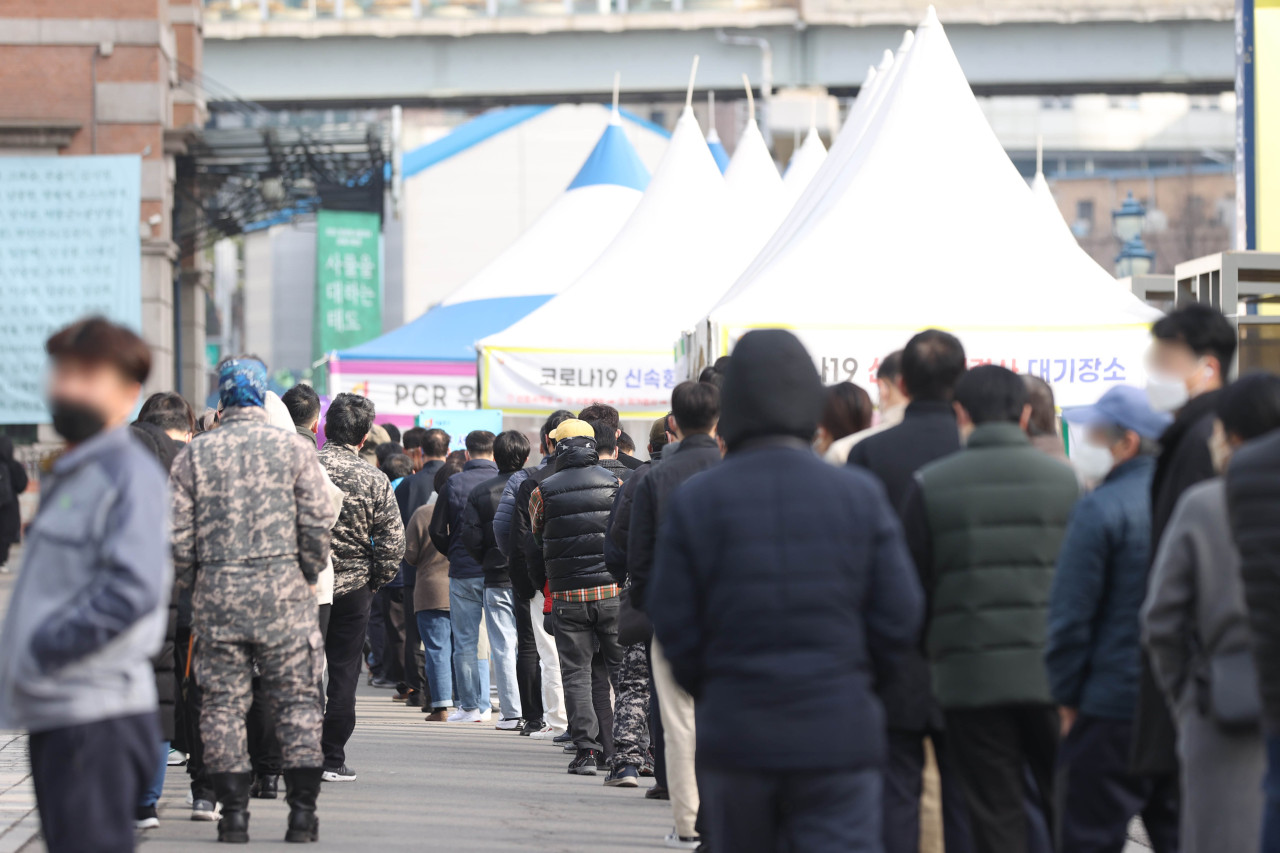S. Korea‘s daily COVID-19 cases fall below 300,000 for the first time in 10 days
By Shim Woo-hyunPublished : March 21, 2022 - 15:48

South Korea‘s daily COVID-19 infections fell below 300,000 for the first time in 10 days on Sunday, prompting the authorities to speculate that the worst may be over.
According to the Korea Disease Control and Prevention Agency, the country added 209,169 new COVID-19 infections on Sunday. The country’s total caseload came to 9,582,815.
South Korea’s daily COVID-19 cases have been dropping for four straight days since the country reached an all-time high of 621,281 COVID-19 cases on Wednesday.
“(The country) is passing through the peak of the omicron wave,” Interior Minister Jeon Hae-cheol said during a COVID-19 response meeting on Monday.
The number of daily COVID-19 cases, however, can potentially rebound during the week as the daily tally tends to decrease over weekends due to fewer tests.
The government’s latest decision to ease social distancing rules can also potentially trigger increases in daily COVID-19 infections.
Starting Monday, the government has raised the limit on private gatherings from six to eight, while maintaining an 11 p.m. curfew on businesses.
Potential impacts from the so-called stealth omicron, which has a 30 percent higher transmission rate than the original omicron variant, have not been fully estimated as well.
Both the US and the UK, which passed peaks of their omicron waves earlier, have been seeing rebounds in the number of daily COVID-19 infections after the stealth omicron variant started to spread.
According to the country’s health authorities, COVID-19 patients infected with the stealth omicron variant accounted for 26.3 percent of the total infections in the second week of March.
Even if the country‘s daily COVID-19 infections is on a downward trend, the increasing number of COVID-19 related deaths and critically ill patients still poses a threat.
On Sunday, the country added 329 new deaths from COVID-19, raising the death toll to 12,757. The fatality rate stood at 0.13 percent.
The number of critically ill patients came to 1,030, also up 97 from the previous day. The hospital bed occupancy rate for seriously ill COVID-19 patients stands at 69 percent, according to the government.
The government previously said the number of COVID-19 deaths and severe cases will peak between March 25 and April 1. The government noted the severe cases are expected to reach between 1,650 and 2,150.
To counter potential surges in COVID-19 deaths and severe cases, the government will continue to focus on treating serious cases and preventing deaths, Jeon said.
The government will increase the turnover rate of hospital beds by speeding up medical assessment of severe cases, which will allow it to secure hospital beds for critically ill patients who need to be urgently admitted in a timely manner.
Jeon added the government will introduce Merck’s oral antiviral medicine Lagevrio for 100,000 patients this week, while seeking an early procurement of additional oral COVID-19 in April.
According to the Korea Disease Control and Prevention Agency, the country added 209,169 new COVID-19 infections on Sunday. The country’s total caseload came to 9,582,815.
South Korea’s daily COVID-19 cases have been dropping for four straight days since the country reached an all-time high of 621,281 COVID-19 cases on Wednesday.
“(The country) is passing through the peak of the omicron wave,” Interior Minister Jeon Hae-cheol said during a COVID-19 response meeting on Monday.
The number of daily COVID-19 cases, however, can potentially rebound during the week as the daily tally tends to decrease over weekends due to fewer tests.
The government’s latest decision to ease social distancing rules can also potentially trigger increases in daily COVID-19 infections.
Starting Monday, the government has raised the limit on private gatherings from six to eight, while maintaining an 11 p.m. curfew on businesses.
Potential impacts from the so-called stealth omicron, which has a 30 percent higher transmission rate than the original omicron variant, have not been fully estimated as well.
Both the US and the UK, which passed peaks of their omicron waves earlier, have been seeing rebounds in the number of daily COVID-19 infections after the stealth omicron variant started to spread.
According to the country’s health authorities, COVID-19 patients infected with the stealth omicron variant accounted for 26.3 percent of the total infections in the second week of March.
Even if the country‘s daily COVID-19 infections is on a downward trend, the increasing number of COVID-19 related deaths and critically ill patients still poses a threat.
On Sunday, the country added 329 new deaths from COVID-19, raising the death toll to 12,757. The fatality rate stood at 0.13 percent.
The number of critically ill patients came to 1,030, also up 97 from the previous day. The hospital bed occupancy rate for seriously ill COVID-19 patients stands at 69 percent, according to the government.
The government previously said the number of COVID-19 deaths and severe cases will peak between March 25 and April 1. The government noted the severe cases are expected to reach between 1,650 and 2,150.
To counter potential surges in COVID-19 deaths and severe cases, the government will continue to focus on treating serious cases and preventing deaths, Jeon said.
The government will increase the turnover rate of hospital beds by speeding up medical assessment of severe cases, which will allow it to secure hospital beds for critically ill patients who need to be urgently admitted in a timely manner.
Jeon added the government will introduce Merck’s oral antiviral medicine Lagevrio for 100,000 patients this week, while seeking an early procurement of additional oral COVID-19 in April.



















![[Today’s K-pop] Treasure to publish magazine for debut anniversary](http://res.heraldm.com/phpwas/restmb_idxmake.php?idx=642&simg=/content/image/2024/07/26/20240726050551_0.jpg&u=)